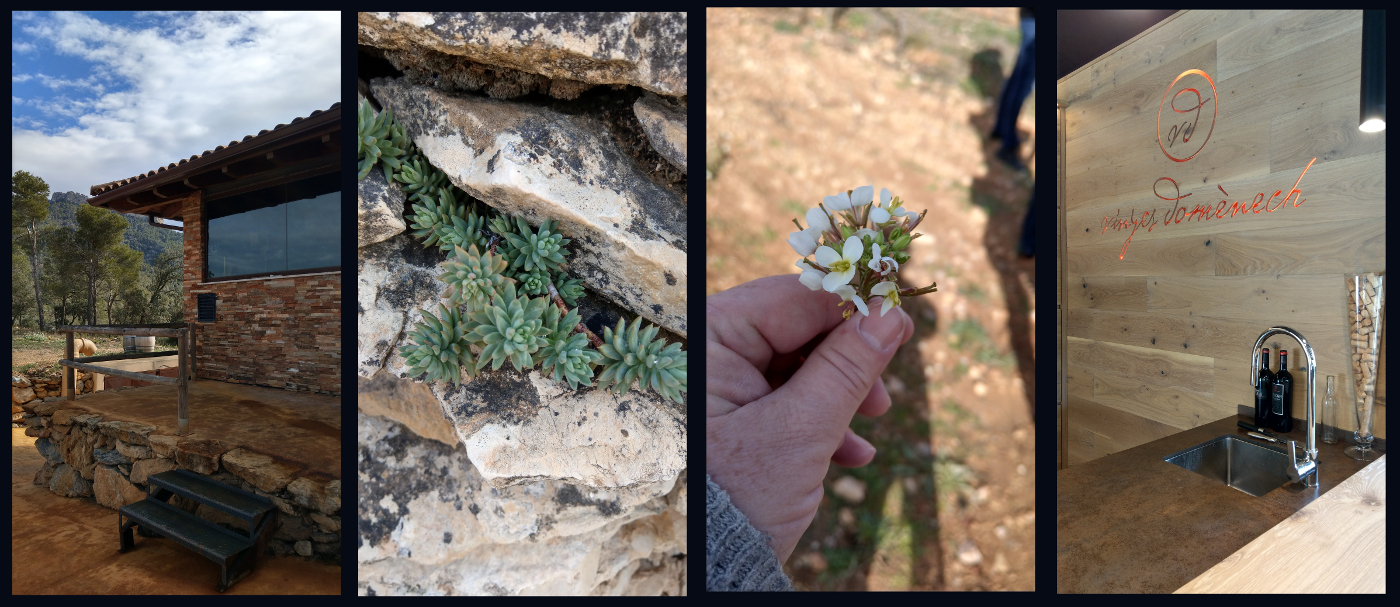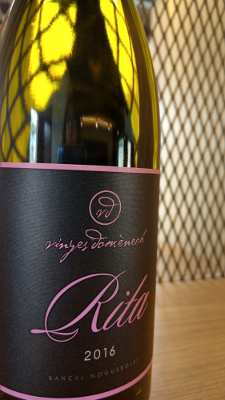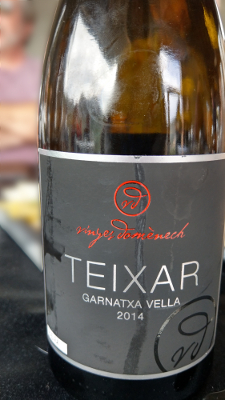As I stand on the path that leads from the tasting room through the vineyard to the edge of a precipice at Vinyes Domènech the Latin phrase in situ comes to mind. Literally, the phrase translates to “on-site.” To the archeologist, an artifact in situ is one that he or she unearths and records at the original site of the culture that created it. When discovered not in situ, the artifact is considered out of context, and not able to give the scientist a true appreciation of its history or its purpose. While I can most certainly appreciate a wine in my glass, or paired with a meal 5,000 miles away in my home city of Houston, there is something about being here, in this place. I am in the vineyard; among the vines that contribute to it, the winemaker who parents it, and the people whose economy depend on it, which makes it all the more special.
Vinyes Domènech sits in a majestic natural amphitheater 450 meters (1,476 feet) above sea level, between the Sierra de Llaberia and the Montalt, part of the Catalan pre-coastal mountain range just 10 kilometers (6.2 miles) from the sea. More specifically, it is in the town of Capçanes, within the Province of Tarragona, county of Priorat in the DO Montsant wine region, our hosts for this visit. The closest major city is Barcelona, Catalunya’s capital and largest metropolis boasting a population of 1.6 million within the city limits, and nearly 5 million people in the extending municipalities: a city filled with many tourists, art, fashion, culture and protests of the recent jailing of politicians set on the region’s independence from Spain.
Less than two hours’ drive from the bustle of Barcelona, there is peaceful calm and breathtaking beauty here in Capçanes. The sky above is a brilliant clear blue with stratocumulus clouds, although off in the distance it is darkening gray. The only sensory intruder is the aroma from the large compost pile, and it so, only as we pass. Limestone terraces frame rows and rows of vines, filled with a myriad of flowering plants. Each of these “cover crops” -- common and wild daisies, Queen Anne’s lace (wild carrots), fennel, Sweet Alison (alyssum), lemon balm, almond, and milk thistle, among others, -- signals the soil’s missing nutrients, depending upon which plant grows. These plants express the unique ecosystem and biodiverse environment created by the Domènech family who established this estate, surrounded by mountains and Mediterranean forests, in 2002, just after Montsant (pronounced “munsan” in Catalan) gained separate DO or Denominació d'Origen (Spanish: Denominación de Origen) status in 2001.
Certified in organic viticulture by Consell Català de la Producció Agrària Ecològica (CCPAE) in 2007, environmentalist-turned-winery owner Joan Ignasi Domènech says he uses biodynamic practices to maintain a harmony between the vineyards and a biodiversity that surrounds, nourishes them and permits “wine production mimetic with its landscape.” By incorporating this and other DO Montsant vineyards in Capçanes, La Figeura and El Masroig, Domènech seeks the highest areas, the oldest vines, and best-suited soils for low yielding vineyards “where Garnatxa and Carinyera can give their utmost expression.”
Domènech did not start out in a wine making family, but the region was in his blood. In fact, he says, until the age of 30 he did not even like wine. His father’s family is from Falset, but fled the area during the Spanish Civil War and settled in Masnou, a tourist city northeast of Barcelona. As a child, Domènech spent summers in the area, he says, so the aromas of wine, mushrooms, hazelnuts and almonds were part of his childhood. It was not until he was 40, and attending a wedding with his children, he decided to take them on a little tour of the area to show them some of the places of his youth. He says his children came to the place where the winery is now located, and thought they were hallucinating – they could not believe that this beautiful landscape was merely an hour and a half from Barcelona. Now he considers the area an integral part of himself and his family.
I walk back from the ledge to the tasting room filled with bottles, dried flowers and herbs, old vines and accolades. We pass a sumptuous leather sofa facing yet another glorious view and pause to take photos through the full wall of glass. We descend a short flight of stairs to tables set for tasting with glasses, soil samples, local cheese and nuts. As our visit is extremely short to stay on schedule, we cannot taste through all of the wines available.
Here are notes, from two that particularly impress
Rita, named for Joan Ignasi’s wife, is a blend of Granatxa Blanca (Grenache Blanc) and Macabeu, one of the base grapes in Cava that gives it youth and freshness. Straw colored in the glass, with an aroma of citrus, pear and rosewater; it is a bit oily in the mouth, round and full-bodied like the mouth feel of a Gewürztraminer. It is silky and elegant, with a lingering finish. It pairs well with the soft local cheeses set out for us. The grapes come from the Serra de Llaberia – Capçanes vineyard with its limestone soils. Fourteen percent (14%) alcohol by volume, in the tasting room a bottle costs 20 euros, equal to about $25 US if you purchase it there. If imported to the United States, it is probably be closer to $100-plus, what with freight, taxes, clearance and margins for the importer, distributor and retailer. Put this on a wine menu, and it is anyone's guess, and every state is different. Maybe $125 or $150. We are talking a pretty exclusive crowd. Only 1000 bottles made, it is an opulent white wine, but I might suggest making the trip to Spain and enjoying the view to appreciate fully.
The 2014 vintage is Vinyes Domènech’s first bottling of a single vineyard Premier Cru Garnatxa (Garnacha/Grenache). Unlike most Grenache in the region made from Garnatxa Negre, this award-winning wine comes from 100 percent 80-year old vine Garnatxa Peluda, or “hairy” Grenache from El Teixar vineyard in Capçanes. So named due to down on the underside of the leaves, these hairs or filaments, and the grapes thicker skins are an adaptation to combat more intense heat and transpiration of this late ripening grape variety, and results in lower alcohol and higher acidity. Ruby in color, this wine is elegant, balanced and complex. Aged 14 months in French oak, 50 percent new, the wine features herbal notes, balsamic and vanilla on the nose with flavors of ripe blackberries, and smoky caramel structured by elegantly confident tannins, with a balsamic finish. Fifteen percent (15%) alcohol by volume, this sells for 45 euros in the tasting room, or about $55 US at the current exchange rate if purchased there. If served with a juicy steak in fine Houston restaurants for those willing to part with $250 to $300 per bottle, it would be yours. It is that good, but would require the leap of faith for many from an affinity toward strident California Cabernet Sauvignon or a restrained Bordeaux.
For those who set themselves apart in the crowd, this one is for you. Better yet, hop on a flight to Barcelona and enjoy in situ, for yourself. But take time to enjoy the wines and savor the view. My pictures just do not do it justice.
For more information or to contact Vinyes Domènech email edgar@vinyesdomenech.com You can learn more about DO Montsant and visiting the region at http://www.domontsant.com/en/
Cheers!
The WineWonkette




